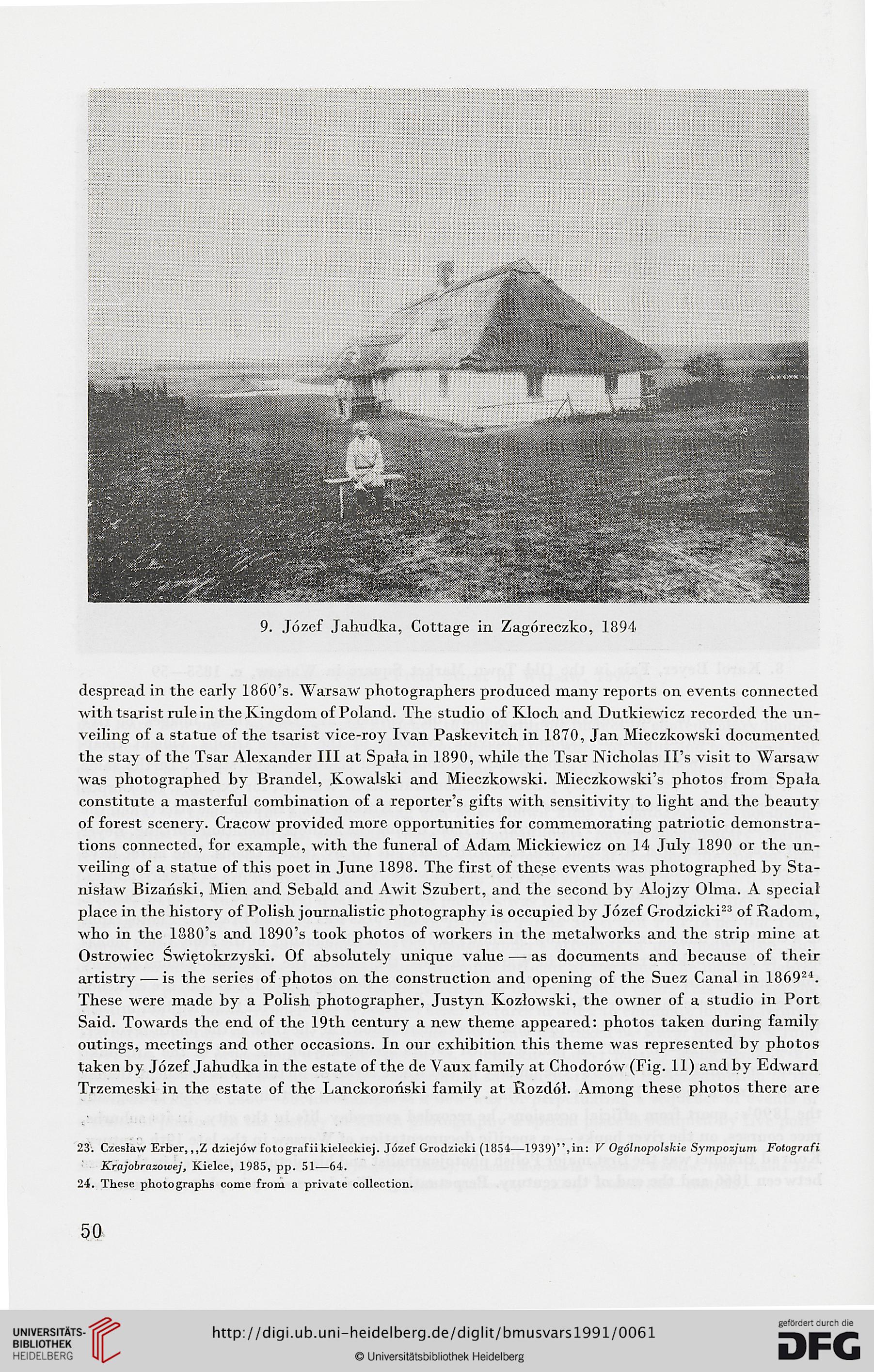9. Józef Jahudka, Cottage in Zagóreczko, 1894
despread in the early 1860's. WarsaW photographers produced many reports on events connected
with tsaristrulein the Kingdomof Poland. The studio of Kloch and Dutkiewicz recorded the un-
veiling of a statuę of the tsarist vice-roy Ivan Paskcvitch in 1870, Jan Mieczkowski documented
the stay of the Tsar Alexander III at Spała in 1890, while the Tsar Nicholas IFs visit to Warsaw
was photographed by Brandel, Kowalski and Mieczkowski. Mieczkowski^ photos from Spala
constitute a masterful combination of a reportcr's gifts with sensitivity to light and the beauty
of forest scenery. Cracow provided more opportunities for commemorating patriotic demonstra-
tions connected, for example, with the funeral of Adam Mickiewicz on 14 July 1890 or the un-
veiling of a statuę of this poet in June 1898. The f irst of these events was photographed by Sta-
nisław Bizański, Mien and Sebald and Awit Szubert, and the second by Alojzy Olma. A special
place in the history of Polish journalistic photography is occupied by Józef Grodzicki23 of Radom,
who in the 1880's and 1890's took photos of workers in the metalworks and the strip mine at
Ostrowiec Świętokrzyski. Of absolutely unique value — as documents and because of their
artistry — is the series of photos on the construction and opening of the Suez Canal in 186924.
These were made by a Polish photographer, Justyn Kozłowski, the owner of a studio in Port
Said. Towards the end of the 19th century a new theme appeared: photos taken during family
outings, meetings and other occasions. In our exhibition this theme was represented by photos
taken by Józef Jahudka in the estate of the de Vaux family at Chodorów (Fig. 11) and by Edward
Trzemeski in the estate of the Lanckoroński family at Rozdół. Among these photos there are
23. Czesław Erber, ,,Z dziejów fotografiikieleckiej. Józef Grodzicki (1854—1939)",in: V Ogólnopolskie Sympozjum Fotografi
Krajobrazowej, Kielce, 1985, pp. 51—64.
24. These photographs cc-me from a privatc collection.
50
despread in the early 1860's. WarsaW photographers produced many reports on events connected
with tsaristrulein the Kingdomof Poland. The studio of Kloch and Dutkiewicz recorded the un-
veiling of a statuę of the tsarist vice-roy Ivan Paskcvitch in 1870, Jan Mieczkowski documented
the stay of the Tsar Alexander III at Spała in 1890, while the Tsar Nicholas IFs visit to Warsaw
was photographed by Brandel, Kowalski and Mieczkowski. Mieczkowski^ photos from Spala
constitute a masterful combination of a reportcr's gifts with sensitivity to light and the beauty
of forest scenery. Cracow provided more opportunities for commemorating patriotic demonstra-
tions connected, for example, with the funeral of Adam Mickiewicz on 14 July 1890 or the un-
veiling of a statuę of this poet in June 1898. The f irst of these events was photographed by Sta-
nisław Bizański, Mien and Sebald and Awit Szubert, and the second by Alojzy Olma. A special
place in the history of Polish journalistic photography is occupied by Józef Grodzicki23 of Radom,
who in the 1880's and 1890's took photos of workers in the metalworks and the strip mine at
Ostrowiec Świętokrzyski. Of absolutely unique value — as documents and because of their
artistry — is the series of photos on the construction and opening of the Suez Canal in 186924.
These were made by a Polish photographer, Justyn Kozłowski, the owner of a studio in Port
Said. Towards the end of the 19th century a new theme appeared: photos taken during family
outings, meetings and other occasions. In our exhibition this theme was represented by photos
taken by Józef Jahudka in the estate of the de Vaux family at Chodorów (Fig. 11) and by Edward
Trzemeski in the estate of the Lanckoroński family at Rozdół. Among these photos there are
23. Czesław Erber, ,,Z dziejów fotografiikieleckiej. Józef Grodzicki (1854—1939)",in: V Ogólnopolskie Sympozjum Fotografi
Krajobrazowej, Kielce, 1985, pp. 51—64.
24. These photographs cc-me from a privatc collection.
50




